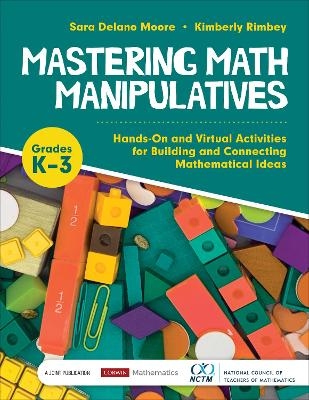
Mastering Math Manipulatives, Grades K-3
Corwin Press Inc (Verlag)
978-1-0718-1604-2 (ISBN)
Would you like to bring math learning to life and make it more concrete, relevant, and accessible to your students? Do you wish you could do more with the manipulatives buried in your supply closet? Do you want to more effectively use virtual manipulatives in your distance learning? Whether physical or virtual, commercial or home-made, manipulatives are a powerful learning tool to help students discover and represent mathematical concepts.
Mastering Math Manipulatives includes everything you need to integrate math manipulatives—both concrete and virtual—into math learning. Each chapter of this richly illustrated, easy-to-use guide focuses on a different powerful tool, such as two-color counters, linking cubes, base ten blocks, fraction manipulatives, pattern blocks, tangrams, geometric solids, and others, and includes a set of activities that demonstrate the many ways teachers can leverage manipulatives to model and reinforce math concepts for all learners. It features:
Classroom strategies for introducing math manipulatives, including commercial, virtual, and hand-made manipulatives, into formal math instruction.
Step-by-step instructions for 75 activities that work with any curriculum, including four-color photos, printable work mats, and demonstration videos.
Handy charts that sort activities by manipulative type, math topic, domains aligned with standards, and grade-level appropriateness.
It′s time to dive in and join in the journey toward making manipulatives meaningful so math learning is concrete, profound, and effective for your students!
Sara Delano Moore is an independent mathematics education consultant at SDM Learning. A fourth-generation educator, her work focuses on helping teachers and students understand mathematics as a coherent and connected discipline through the power of deep understanding and multiple representations for learning. Sara has worked as a classroom teacher of mathematics and science in the elementary and middle grades, a mathematics teacher educator, Director of the Center for Middle School Academic Achievement for the Commonwealth of Kentucky, and Director of Mathematics & Science at ETA hand2mind. Her journal articles appear in Mathematics Teaching in the Middle School, Teaching Children Mathematics, Science & Children, and Science Scope. Kimberly Rimbey is an author, inventor, entrepreneur, speaker, consultant, coach, mentor, advocate, and, proudest of all, a teacher through and through. Kim currently serves as the Chief Learning Officer and CEO at KP® Mathematics and an Official Building Thinking Classrooms Consultant alongside Peter Liljedahl. A life-long teacher and learner, her heart’s work centers on equipping teachers and helping them fall in love with teaching and learning over and over again. Always a teacher at heart, Kim has held several leadership positions, including Executive Director of Curriculum and Instruction, Chief Learning Officer, and Mathematica Program Area Coordinator. That said, everything Kim has done in her career is based on what she learned during her 18 years as a mathematics coach and classroom teacher. Kim is National Board Certified in Early Adolescent Mathematics, and she is a recipient of the Presidential Award for Excellence in Mathematics Teaching. Kim is the co-inventor of KP® Ten-Frame Tiles and has authored and co-authored several publications, including the Mastering Math Manipulatives and Meaningful Small Groups in Math for Corwin, Math Power: Simple Solutions for Mastering Math for the Rodel Foundation of Arizona, and, most recently, The Amazing Ten Frame series for KP Mathematics. Kim earned her BA in Elementary Education and Mathematics from Grand Canyon University, her M.Ed. degrees in Early Childhood Education and Educational Leadership from Arizona State University and Northern Arizona University, and her Ph.D. in Curriculum and Instruction from Arizona State University. Kim lives in Phoenix, Arizona, where she continues to inspire teachers and their leaders.
Chapter 1: Two-Color Counters (and other kinds of counters)
Chapter 2: Linking Cubes
Chapter 3: Cuisenaire® Rods
Chapter 4: Unit Squares
Chapter 5: Base-Ten Blocks
Chapter 6: Pattern Blocks
Chapter 7: Fraction Manipulatives (Towers, Circles, Tiles/Bars, and Squares)
Chapter 8: Tangrams & Geoboards
Chapter 9: Geometric Solids
Chapter 10: Continuing the Journey
| Erscheinungsdatum | 08.11.2021 |
|---|---|
| Reihe/Serie | Corwin Mathematics Series |
| Verlagsort | Thousand Oaks |
| Sprache | englisch |
| Maße | 215 x 279 mm |
| Gewicht | 780 g |
| Themenwelt | Schulbuch / Wörterbuch |
| Sozialwissenschaften ► Pädagogik ► Schulpädagogik / Grundschule | |
| ISBN-10 | 1-0718-1604-7 / 1071816047 |
| ISBN-13 | 978-1-0718-1604-2 / 9781071816042 |
| Zustand | Neuware |
| Haben Sie eine Frage zum Produkt? |
aus dem Bereich


